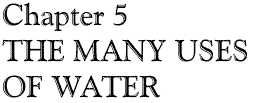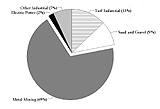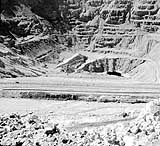
| ch. 5, pp. 59 - 60 |
Another strategy for reducing agricultural water use is to buy agricultural land and the attached water rights to either convert rights to municipal use or permanently retire the water rights. The City of Tucson bought many acres of farmland from the 1950s through the 1970s, and mining companies also purchased farmland in the 1970s to secure water rights. The GMA has provisions for state purchase of farmland to retire agricultural water rights starting in the year 2006 but no source of funds has been identified to accomplish this goal. Industrial water users in the Tucson AMA include metal mines, sand and gravel mining facilities, electric power producers, dairy operations, and other industrial users. As is shown in Figure 5-14, metal mining is the largest water user in the industrial sector, accounting for approximately 70 percent of the total. classifies some golf courses and other turf facilities with their own wells as industrial for legal reasons. All turf uses, however, were previously discussed as municipal uses. Mining Four active metal mines operate in TAMA. The Cyprus Sierrita and Cyprus Twin Buttes mines are located adjacent to each other, south of Tucson and west of Green Valley. Water use at theses two mines totaled 26,165 acre-feet in 1997. The ASARCO Mission Mine is located several miles north of the Cyprus Sierrita/Twin Buttes mines. Copper and molybdenum are mined at two open pits and an underground mine at the site. A substantial amount of silver also is recovered as a by-product. Water use at the Mission Mine was 13,042 acre-feet in 1997. The ASARCO Silver Bell Mine straddles the TAMA boundary due west of Marana. Copper is mined in an open pit. Water use at the site was 575 acre-feet in 1997. On-site production capacity has been expanded with the mining of a new deposit and the addition of a new processing plant. Most mining in the Tucson AMA is open-pit mining followed by milling and flotation. The ore extracted from the pits is crushed and delivered to the mill, where it is crushed again and mixed with water to form a slurry. The slurry is discharged to flotation cells. Here chemicals are added that cause the materials to float to the surface for removal. Waste rock remaining in the flotation cells is sent to thickener tanks. The solids settle in the tanks and the water is recovered. The tailings mixture, which usually is 46 to 55 percent solids by weight, is transported via pipeline to the tailings pond. The tailings slurry is deposited in the tailings impoundment with a spray, leaving standing water in the impoundment which is skimmed off and recycled back to the mill. At the Mission Mine and the Sierrita/Twin Buttes facility, approximately 30 percent of water sent to the tailings is recovered. Copper also can be leached from piles of certain types of ore using sulfuric acid. The leachate is then piped to another facility for recovery of copper. Another form of leaching from buried ore, known as “in situ” leaching, has recently come into use. Both types of leaching use less water than milling and flotation, but “in situ” leaching has been applied only on a pilot scale in Pinal County, and both forms require the right kind of ore.
ADWR funded a study to analyze possibilities for additional water conservation in mining. Increasing the density of the tailings slurry was one of the most effective steps available to decrease groundwater withdrawals. For every one percent increase in the tailings density, 500 to 800 acre-feet of groundwater can be saved per year. Average tailing densities may be able to be increased from 48 percent to 50 percent at ASARCO Mission and from 52 percent to 54 percent at Cyprus Sierrita by installing smooth plastic piping to reduce friction and by pumping the slurry instead of relying on gravity. In addition, seepage of groundwater underneath the tailings ponds can be reduced by depositing fine-grained tailings on top of native soils before tailings are delivered to the ponds. Evaporation of water in tailings impoundments can be reduced by installing multiple decant towers to more quickly decant the water.
The 1997 study also examined the possibility of using renewable supplies instead of groundwater at the mines. The study found that the use of renewable supplies at the mines is unlikely to include effluent, due to the great distance between existing effluent lines and the mines. Use of CAP water was deemed theoretically possible, but several obstacles currently prevent use of this water source. First, the mines have the legal right to pump groundwater, and groundwater is significantly cheaper than CAP water. While total water use at these sites in 1997 was 39,207 acre-feet, the mines have rights to withdraw a total of 62,188 acre-feet of groundwater per year. Mines were originally expected to use CAP water in the Tucson area, but no mining facilities signed subcontracts for CAP water. The best incentive for mines to use CAP water would be if its price was lowered to equal the cost of pumping groundwater. This price adjustment likely would have to come as a subsidy from other water users. The cost of pumping groundwater, including energy and maintenance costs, was reported to be $84 per acre-foot at the ASARCO Mission Mine and $163 per acre-foot at Cyprus Sierrita in 1997. Another obstacle to mines using CAP water is its quality. If mines use CAP water instead of groundwater, the process of recovering metals from the ore would not be as efficient. Tests conducted by the mines show that use of 100 percent CAP water resulted in declines in copper and molybdenum recovery. More study is needed to assess the potential impact on recovery rates when using a blend of CAP and groundwater. Yet another obstacle to CAP water use is the question of CAP delivery reliability. Mines need water for ore extraction 24 hours a day, seven days a week. CAP water delivery interruptions would cause fluctuations in the quality of water delivered to the mill storage reservoirs and result in a need to readjust the rates at which chemicals are added to maintain mineral recovery efficiencies. Emergency outages present the greatest problem in adjusting to changes in water quality because of the lack of advance warning.
|


